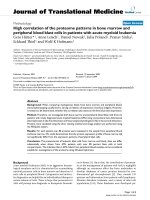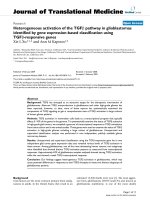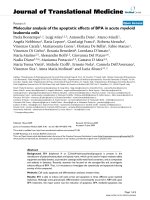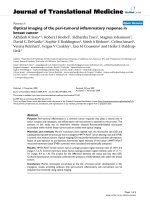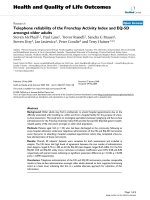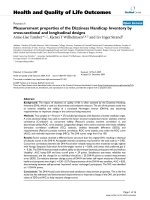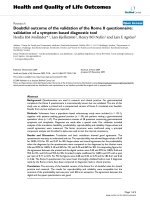báo cáo hóa học: " Conceptual adequacy of the neuropathic pain symptom inventory in six countries" pptx
Bạn đang xem bản rút gọn của tài liệu. Xem và tải ngay bản đầy đủ của tài liệu tại đây (227.09 KB, 8 trang )
BioMed Central
Page 1 of 8
(page number not for citation purposes)
Health and Quality of Life Outcomes
Open Access
Research
Conceptual adequacy of the neuropathic pain symptom inventory
in six countries
Bruce Crawford*
†1
, Didier Bouhassira
†2
, Audrey Wong
†1
and Ellen Dukes
†3
Address:
1
Mapi Values, 15 Court Square, Suite 620, Boston, MA, 02108, USA,
2
Hôpital Ambroise Paré, 9, avenue Charles de Gaulle, 92100,
Boulogne-Billancourt, France and
3
Pfizer Inc., 235 E 42nd St, New York, NY, 10017, USA
Email: Bruce Crawford* - ; Didier Bouhassira - ;
Audrey Wong - ; Ellen Dukes -
* Corresponding author †Equal contributors
Abstract
Background: Neuropathic pain results from a nerve lesion or nerve damage. Because it is a
subjective experience, patient-reported outcomes may measure both the symptoms and impact on
the patient's life. The purpose of this study was to determine whether the Neuropathic Pain
Symptom Inventory (NPSI) adequately assesses neuropathic pain symptoms in patients with
diabetic peripheral neuropathy, post-herpetic neuralgia, trigeminal neuralgia, and sciatica across
multiple cultures.
Methods: From data collected from 132 subjects in 6 countries, qualitative research methods
identified their most important symptoms (and verbal descriptions) associated with neuropathic
pain. A core set of commonly described symptoms spanning multiple cultures was also described.
Moderators using a semi-structured discussion guide conducted focus groups consisting of patients
in the U.S., Brazil, Japan, China, Finland, and Spain to elicit concepts that were most important and
relevant (concept elicitation phase). Study subjects ranked the importance of each neuropathic pain
symptom, completed the NPSI, and commented on its ability to capture key symptoms (face and
content validation phase).
Results: Descriptive terms for sensations of neuropathic pain were similar in all countries; burning,
electric shocks, and pins and needles were among the most-common sensations. Individuals with
neuropathic pain experienced all sensations that were included in the NPSI. They also tended to
describe pins and needles and numbness interchangeably, perhaps reflecting the relative number of
DPN subjects on study.
Conclusion: Based on data from these focus groups, the NPSI is an acceptable instrument for
assessing neuropathic pain.
Background
Neuropathic pain results from a nerve lesion or nerve
damage and may be experienced as burning, electric
shock-like, sharp stabbing pains that come and go, deep
aches that make sleep or normal activities difficult, or very
sensitive skin that reacts to even a slight touch [1,2]. These
sensations not only affect the sensory system, but also
translate into a wider impact on patients' health related
quality of life in terms of alterations in sleep patterns, con-
centration and mood. Neuropathic pain has been defined
Published: 18 August 2008
Health and Quality of Life Outcomes 2008, 6:62 doi:10.1186/1477-7525-6-62
Received: 12 January 2008
Accepted: 18 August 2008
This article is available from: />© 2008 Crawford et al; licensee BioMed Central Ltd.
This is an Open Access article distributed under the terms of the Creative Commons Attribution License ( />),
which permits unrestricted use, distribution, and reproduction in any medium, provided the original work is properly cited.
Health and Quality of Life Outcomes 2008, 6:62 />Page 2 of 8
(page number not for citation purposes)
by the International Association for the Study of Pain as
pain initiated or caused by a primary lesion or dysfunc-
tion of the nervous system [3]. Due to the fact that some
researchers find this definition overly broad, neuropathic
pain has also been characterized as pain caused by lesions
of the peripheral or central nervous system (or both) that
manifest sensory symptoms or signs [4]. The assessment
of neuropathic pain is often complex, given that it is asso-
ciated with a wide variety of chronic diseases or condi-
tions such as diabetes, carpal or ulnar nerve entrapments,
sciatica, spinal cord injury and neuralgia [5].
Neuropathic pain is a subjective experience and the use of
patient-reported outcomes (PROs) in measuring symp-
toms and their manifestation into the patient's life is
important. There are several evaluative instruments deal-
ing with neuropathic pain [6-9]. Selecting appropriate
measures for the complex assessment of neuropathic pain
is challenging. Regulatory agencies have developed guide-
lines that direct researchers on the development and vali-
dation of PRO measures [10,11]. In order for an
instrument to be considered well developed, the new
guidelines have specified several key points. The develop-
ment of the instrument must include patient involvement
to assist in developing the concepts to be measured or, as
the guidelines infer, the question generation process
would be incomplete. A wide range of patients should be
included in the development of a questionnaire to ensure
a representative sample and variations in population char-
acteristics. Following the development of the questions, it
is important to review these questions with patients to
ensure their clarity and relevance. A questionnaire is not
considered valid until the statistical properties have been
tested.
The new guidelines direct researchers on the validation
steps to ensure the measurement properties are adequate
for use in clinical trials. Regulatory agencies want to be
sure the questionnaire reliably measures the concepts it
was designed to measure. It should be noted, however,
that the statistical testing of the questionnaire should
guide the development and not dictate which items
remain in the questionnaire. Relevance to the patient and
clinical importance should always be considered. Most
questionnaires were developed solely based on clinical
expert opinions regarding which symptoms subjects expe-
rience and not the patients' perspective on treatment out-
comes – an important scientific standard in questionnaire
development [10]. In addition, perceptions and descrip-
tions of neuropathic pain might possibly differ between
cultures. Thus, to ensure that the questionnaire is suitable
for use in worldwide clinical trials, it should not reflect
cultural bias.
This study evaluates the face and content validity of the
Neuropathic Pain Symptom Inventory (NPSI) [8]. The
NPSI was developed to assess more specifically the differ-
ent components of neuropathic pain syndromes (i.e.
spontaneous ongoing and paroxysmal pain, evoked pain,
paresthesia/dysesthesia). This self-questionnaire includes
ten items related to different pain descriptors (e.g. burn-
ing, squeezing, electric-shock, stabbing, tingling) allowing
the assessment of the different dimensions of neuropathic
pain and two items on frequency and duration of pain.
Each of the items has a recall of the past 24 hours and
items are rated on an 11-point numeric rating scale
anchored by 0: No (symptom) and 10: Worst (symptom)
imaginable. We employed qualitative research methods
to identify symptoms deemed most important to the sub-
jects affected by neuropathic pain and the manner in
which the subjects describe those symptoms. Because the
NPSI may be used to study several forms of neuropathic
pain, it is important to establish a core set of neuropathic
pain symptoms. Therefore, this assessment focuses on a
core set of symptoms commonly described as symptoms
in neuropathic pain that also span multiple cultures.
The objective of this study was to determine if the NPSI
adequately assesses neuropathic pain symptoms, and is
acceptable and relevant to patients with diabetic periph-
eral neuropathy (DPN), post-herpetic neuralgia (PHN),
trigeminal neuralgia (TN), and sciatica across multiple,
diverse cultural norms.
Methods
Recruitment
Focus groups in six countries (U.S. [English], Brazil [Por-
tuguese], Japan [Japanese], China [Mandarin], Finland
[Finnish], Spain [Spanish]) were designed to elicit con-
cepts that were most important and relevant to patients
with neuropathic pain. Subjects were recruited through
pain specialists via recruitment agencies. The recruitment
agencies initiated contact with pain specialists who
invited subjects to participate in the study. Subjects
received an informational letter outlining the purpose of
the study and the extent of their involvement, and physi-
cians obtained informed consent prior to study. Both sub-
jects and their physicians were required to complete a case
report form (CRF) that included clinician and subject con-
tact information and ensured the eligibility of the subject
through a list of inclusion and exclusion criteria. Subjects
were informed that the focus group session would last
approximately two hours. The CRFs were reviewed for
completeness and patient eligibility prior to beginning the
focus group sessions.
Six to ten subjects were recruited for each focus group. An
attempt was made to recruit subjects of differing age, gen-
der, and ethnicity (the latter only in the U.S.). Subjects
Health and Quality of Life Outcomes 2008, 6:62 />Page 3 of 8
(page number not for citation purposes)
with mild to severe neuropathic pain were included to
capture the full spectrum of patient pain.
Inclusion/exclusion criteria
Study inclusion criteria included: 18 years of age or older;
diagnosed with DPN, PHN, TN, or sciatica; able to discern
his/her neuropathic pain from any concomitant pain
(e.g., joint pain) as determined by their physician; and
ability to participate in a two-hour focus group discus-
sion. In addition, subjects met at least three of the follow-
ing inclusion criteria (abstracted from the ID Pain [12]) to
verify the presence of neuropathic pain: described his/her
pain as feeling like pins and needles; described his/her
pain as feeling like hot/burning; described his/her pain as
feeling numb; has described his/her pain as feeling like
electrical shocks; and/or reported that his/her pain is
worsened by the touch of clothing or bed sheets. Exclu-
sion criteria included: serious mental health or cognition
condition(s), including cognitive impairment, severe
mental retardation, schizophrenia, and/or physician-
assessed clinical depression.
Prior to the initiation of the focus groups, subjects com-
pleted forms for informed consent and background
demographics, as well as pre-focus group questionnaires.
These questionnaires asked subjects to list five terms that
describe their nerve pain in conjunction with the five
most-bothersome symptoms (i.e., "People feel pain in many
ways and people might describe pain using many different
terms. We are interested in how you would describe your nerve
pain. Please list below five words that you would use to describe
your nerve pain;" and "Please list below the three most bother-
some sensations you feel related to your nerve pain."). Collect-
ing this information spontaneously prior to discussing the
topic with other subjects via questionnaire avoids the
potential introduction of error through "yeah-saying" in
the focus groups.
Concept elicitation and content validation
Trained moderators conducted the focus group sessions
using a semi-structured discussion guide. Prior to the start
of the focus group, the moderators explained the purpose
of the study, reassured the subjects of the confidentiality
of their responses, encouraged the subjects to take their
time with their responses, and allowed all subjects an
opportunity to share their views with the group. The mod-
erator informed the participants that the focus group ses-
sions would be audio- and/or video-recorded as stated in
the consent form that each participant had signed prior to
the focus group. The focus group guide consisted of: 1) a
concept elicitation phase, and 2) face and content valida-
tion phase. During the concept elicitation phase, subjects
received open-ended questions about their neuropathic
pain experiences, focusing on symptoms they experienced
due to their neuropathic pain. Subjects identified and
described such sensations in detail. Initially, subjects
responded spontaneously to these questions. If sensations
previously described in the questionnaire were not men-
tioned spontaneously, the moderator probed the subjects
to determine the accurateness of the sensations. These
questions were asked prior to the content validation phase
of the interview to ensure that the subjects were not
unduly biased by the sensations covered in the NPSI. This
allowed for a pure assessment of symptoms prior to the
face and content validation of the questionnaire and a
more guided assessment of symptoms during the second
phase of the focus group.
During the concept elicitation phase, the importance of
each neuropathic pain symptom was ranked by patients
detailing the "most bothersome" sensation they experi-
ence. During the face and content validation phase of the
focus groups, the subjects completed the NPSI and com-
mented on the extent to which the questionnaire captured
key symptoms associated with neuropathic pain. The pur-
pose of this phase of the focus groups was to ensure: 1) the
relevance of the concepts covered by the questionnaire, 2)
the questionnaire's comprehensiveness and ease of under-
standing, and 3) the applicability/acceptability of the
items.
Transcription/translation
Transcriptions were produced from the audiotapes of the
sessions, and verbatim subject comments were analyzed.
Recordings in Japanese, Spanish, Portuguese, and Chinese
were transcribed into the respective native language prior
to English translation. The English transcripts of the other
countries' focus group data were then analyzed. The Finn-
ish tapes were transcribed into Finnish and then analyzed
in the native language. Subject quotes were grouped
together by symptom and compared to the symptoms
included in the NPSI.
Coding schemes were developed to translate descriptions
of patient characteristics into thematic trends for data
analysis. The thematic coding scheme underwent itera-
tions as the research team coded the preliminary data. Ini-
tial coded material was aggregated into broader core
categories and analyzed using grounded theory methods
[13]. For the concept elicitation sections of the focus
groups, each subject comment was assigned a "classifica-
tion" and "domain" and incorporated into a domain
mapping grid. The classifications and domains identified,
along with examples of subject quotes, were used as a
basis for determining whether all relevant symptoms were
included in the NPSI.
Results and discussion
One hundred and thirty-two subjects from six countries
were interviewed (Table 1), Background demographics,
Health and Quality of Life Outcomes 2008, 6:62 />Page 4 of 8
(page number not for citation purposes)
including age and gender are summarized in Table 2. The
type of neuropathic pain and clinician-rated severity of
pain are included in Table 3.
In the U.S., the majority of the subjects (72%) were Cau-
casian. The remaining participants were African American
(8%), Hispanic/Latino (11%), and from other ethnic
groups (3%). As illustrated in Table 2, there was some var-
iability by country in both educational level and marital
status. Ethnicity was not collected in the other countries
due to the ethnic homogeneity for each country. It should
be noted that with the exception of the U.S., focus groups
were conducted in or around major cities – Sao Paulo, Bei-
jing and Shanghai, Seinajoki (smaller city in western Fin-
land), Madrid and Tokyo.
Pre-focus group findings
Table 4 summarizes the spontaneous, independent report
of symptoms by subjects on the pre-focus group question-
naire, as described in Methods. The most frequently listed
words to describe neuropathic pain were "burning," "elec-
tric shock," "numbness," and "tingling"; however, not all
of the subjects listed sensations.
"Squeezing" and "pressure" were the least likely sensa-
tions on the NPSI to be elicited spontaneously on the pre-
focus group questionnaire. "Pressure" was reported in
every country except Brazil and "squeezing" was only
mentioned in Finland.
All sensations covered in the NPSI were mentioned spon-
taneously as being most bothersome on the pre-focus
group questionnaire except for squeezing. The most fre-
quent notations of bothersome were burning, tingling,
and electric shocks.
Focus group findings
Phase 1
During the focus groups, the most common spontaneous
descriptions were burning, electric shocks, numbness, and
pins and needles. Subjects often used terms interchangea-
Table 1: Focus Group Populations
Country Number of focus groups Total number of subjects
United States 6 50
Brazil 1 (plus 10 individual in-depth
interviews)
a
16
China 2 18
Finland 2 17
Spain 2 16
Japan 2 13
a
Conducted in place of a focus group due to scheduling conflicts.
Table 2: Focus Group Demographics
Demographic Information U.S.
(N = 50)
Brazil
(N = 16)
China
(N = 18)
Finland
(N = 17)
Spain
(N = 16)
Japan
(N = 13)
n (%) n (%) n (%) n (%) n (%) n (%)
Gender
- Female 24 (48) 9 (56) 8 (44) 11 (65) 13 (81) 5 (38)
- Male 26 (52) 6 (38) 9 (50) 6 (35) 3 (19) 8 (62)
- Missing Data 0 (0) 1 (6) 1 (6) 0 (0) 0 (0) 0 (0)
Age
- Range 19–81 years 50–76 years 28–61 years 43–90 years 23–78 years 54–80 years
- Mean 52 years 62 years 47 years 70 years 66 years 66 years
- Median 51 years 61 years 66 years 61 years 72 years 64 years
Education*
- Less than high school 4 (8) 9 (56) 9 (50) 15 (88) 10 (63) 3 (23)
- High school diploma/Some college 28 (56) 7 (44) 3 (17) 4 (25) 5 (38)
- College or university degree (2 or 4 year) 16 (32) 6 (33) 2 (12) 4 (31)
Marital Status**
- Married 31 (62) 10 (63) 18 (100) 10 (59) 9 (56) 12 (92)
- Not married 19 (38) 6 (37) 7 (41) 7 (44)
* Note: Two patients from the U.S. did not respond; two patients from Finland did not respond; one patient from Japan did not respond.
**Note: One patient from Japan did not respond.
Health and Quality of Life Outcomes 2008, 6:62 />Page 5 of 8
(page number not for citation purposes)
bly; for example, in the U.S., "tingling" and "numbness"
were described as "pins and needles."
In Brazil, all symptoms on the NPSI were spontaneously
mentioned in the focus group except "squeezing" and
"tingling." After probing, subjects also reported experienc-
ing "squeezing." "Tingling" was the only sensation not
mentioned by the subjects in Brazil. "Cramps" were
described as "similar to twinging" and "coming after the
burning pain." After a discussion with a professional
translator, it was discovered that "twinging" might be the
English translation of the Brazilian word for "tingling."
One patient described "twinging" as "stabbing by nee-
dles."
In China, subjects also used the terms "heart stabbing,"
"needle through heart," "tremble," and "bursting" to
describe their pain. Interviewers in China noted that these
Table 3: Focus Group Health Information
Health
Information
U.S.
(N = 50)
Brazil
(N = 16)
China
(N = 18)
Finland
(N = 17)
Spain
(N = 16)
Japan
(N = 13)
n (%) n (%) n (%) n (%) n (%) n (%)
Type of Neuropathic Pain
- Diabetic Peripheral Neuropathy 18 (36) 14 (88) 5 (28) 0 (0) 1 (6) 5 (38)
- Post-Herpetic Neuralgia 10 (20) 1 (6) 6 (33) 5 (29) 10 (63) 8 (62)
- Trigeminal Neuralgia 8 (16) 1 (6) 7 (39) 12 (71) 4 (25) 0 (0)
- Sciatica 14 (28) 0 (0) 0 (0) 0 (0) 0 (0) 0 (0)
- Missing data 0 (0) 0 (0) 0 (0) 0 (0) 1 (6) 0 (0)
Clinician-rated pain level
- Mild 15 (30) 3 (19) 1 (6) 0 (0) 0 (0) 3 (23)
- Moderate 26 (52) 12 (75) 13 (72) 1 (6) 9 (56) 6 (46)
- Severe 9 (18) 1 (6) 4 (22) 16 (94) 7 (44) 4 (31)
Table 4: Sensations of Neuropathic Pain Included in the NPSI Compared to Sensations Reported on the Pre-Focus Group
Questionnaire
Neuropathic Pain
Sensations of
Included in the NPSI
Sensations of Neuropathic Pain Reported on Pre-Focus Group
Questionnaire
U.S.
(n = 50)
Brazil
(n = 16)
China
(n = 18)
Finland
(n = 17)
Spain
(n = 16)
Japan
(n = 13)
Burning 1257151
Squeezing 3
Pressure 1 1 3 1 2
Electric Shocks 5 3 5 7 4 5
Stabbing 5 7 5 1
Pins and Needles 5 1 5 6
Tingling 6 5 11 2
Non-NPSI Sensations
Numbness 927223
Prickling 2 2
Itchiness 7 8 4
Sharp 9
Shooting 5 3
Throbbing 2
Stinging 4 1
Piercing 1
Cramps 1 1
Cutting 3 5
Hot 1 1
Pulsating 1
Drilling 1
Health and Quality of Life Outcomes 2008, 6:62 />Page 6 of 8
(page number not for citation purposes)
terms should not be interpreted literally. "Bursting"
implies a "sudden, strong, and unbearable" feeling of
pain. The two terms referring to the heart do not mean
that the heart is in pain. When speaking about pain, the
Chinese are more likely to relate extreme pain with the
heart because they believe the heart is the most critical and
sensitive part of the body.
In Spain, the two sensations of "pins and needles" and
"stabbing" were combined into one term as "stabbing
pins on fire" (n = 8). One subject defined it as if "hun-
dreds, thousands of pins on fire (are) stuck into my
body."
Table 5 summarizes the pain sensations experienced by
the focus group members that they spontaneously
described. The symptoms of the NPSI were consistently
reported within the focus groups with the exception of
"squeezing." Although "squeezing" was reported in the
U.S., Finland and Japan, few subjects stated this as a spon-
taneous expression of their pain. "Squeezing" was only
spontaneously mentioned by one subject and four sub-
jects mentioned "squeezing" while describing other neu-
ropathic pain sensations.
All of the sensations of neuropathic pain included in the
NPSI (e.g., burning, squeezing, pressure, electric shocks,
stabbing, pins and needles, and tingling) were spontane-
ously mentioned by subjects during the focus groups. Of
the sensations included in the NPSI, "burning," "pins and
needles," and "electric shocks" were most frequently men-
tioned by subjects in the focus groups. Subjects in China
did not spontaneously mention three of the seven items
(e.g., squeezing, pressure, and stabbing).
In addition to symptoms included on the NPSI, subjects
also frequently mentioned "numbness" and "sharp" as
sensations they experienced, although "sharp" was only
mentioned in the U.S.
Patients in each country consistently described their pain
with a single statement. Subjects in the U.S. used "burn-
ing," "electric shocks," and "sharp" while those in Spain
used "electric shocks" or "sharp" only. Finnish and Japa-
nese subjects also described their pain as "electric shocks,"
In addition, Japanese subjects used the term, "pins and
needles."
The two most bothersome sensations in the U.S. were
burning and electric shocks while the two most bother-
some sensations in Brazil were cramps and pins and nee-
dles. The most bothersome sensations for Spanish
subjects were either electric shocks or "stabbing pins on
fire." Interestingly, subjects in China defined their worst
pain by the emotions they felt or their inability to sleep in
addition to the type and duration of the pain episode.
Review of the Neuropathic Pain Symptom Inventory
questionnaire
The majority of the subjects did not raise any concerns
with the NPSI: only three subjects mentioned that the
recall period was too short, one subject felt that the ques-
tionnaire was confusing and another thought it did not
capture all of their symptoms. Subjects responded posi-
tively when asked if the questionnaire was easy to under-
stand, though one person reported that they did not know
what was meant by "squeezing" pain. Next, subjects were
asked which words (or kanji characters) they thought
were above a sixth-grade reading level. The majority of
subjects in other countries stated no concerns; however,
words that some U.S. subjects thought were above a six-
grade reading level included imaginable, neuropathic,
provoke, severity, spontaneous, stimulation, and sensa-
tion. Although not thought to be above a six-grade read-
ing level, Japanese subjects suggested that "pressure" was
a concept that may be difficult to understand. However,
no changes to the NPSI were consistently suggested by
focus group subjects.
Table 5: Sensations Reported in the Focus Groups
Sensations of
Neuropathic Pain
Included in the NPSI
Sensations of Neuropathic Pain Spontaneously Mentioned by Subjects
During the Focus Groups
U.S.
(n = 50)
Brazil
(n = 16)
China
(n = 18)
Finland
(n = 17)
Spain
(n = 16)
Japan
(n = 13)
Burning 14102 211
Squeezing 1 5 1
Pressure 6 3 5 5 2
Electric Shocks 10 3 2 10 15 6
Stabbing 62 183
Pins and Needles 8 7 6 1 5 4
Tingling 622312
Health and Quality of Life Outcomes 2008, 6:62 />Page 7 of 8
(page number not for citation purposes)
In China, four subjects felt that the questionnaire did not
adequately reflect Chinese and/or Asian culture, and they
suggested using a simplified NPSI. Because pain is not
judged on a numerical scale, patients did not define their
pain in such detail. Instead, subjects in China typically
used descriptive terms ("mild," "moderate," or "severe")
rather than numbers to quantify pain. However, five indi-
viduals felt that the NPSI was an acceptable tool, even if it
incorporated a scale to measure pain.
Conclusion
The focus groups and interviews consisted of 2 phases: 1)
concept elicitation, and 2) face and content validation.
The information gathered from the focus groups in other
countries (e.g., Japan, Brazil, China, Finland, and Spain)
was consistent with that from group in the U.S. Descrip-
tive terms for sensations of neuropathic pain were similar
in all countries studied. Burning, electric shocks, and pins
and needles were among the most-common sensations.
Based on feedback from focus group subjects during the
concept elicitation phase, all sensations included in the
NPSI are indeed experienced by people with neuropathic
pain. During the focus groups or individual interviews,
subjects used the terms burning, electric shocks, and pins
and needles.
Numbness was also consistently mentioned. Although
"numbness" is not a true pain descriptor but is related to
non-painful paresthesia/dysesthesia, the occurrence of
numbness as a frequently reported sensation reflects the
number of DPN subjects in the focus groups, as this sen-
sation is typically experienced in DPN. Subjects also used
the words numbness and pins and needles interchangea-
bly to describing pain symptoms. Because pins and nee-
dles are already included in the NPSI, adding numbness
should be considered when a DPN-specific questionnaire
is required. Because numbness would not be a compo-
nent of the validated scoring algorithm, this issue would
be considered separately. Similarly, "itchiness" is not a
true pain descriptor. In the validation of the NPSI [8],
"itchiness" was found to be an unreliable item and there-
fore was removed. This study, unfortunately, was not
designed to evaluate the "global" reliability of responses
and therefore, we cannot recommend its inclusion at this
time. The descriptor of "squeezing" was not consistently
reported across cultures; however, "pressure" was reported
more consistently. These two descriptors have been found
to belong to the same pain dimension [8] – spontaneous
ongoing pain, with similar factor loadings (0.88 and 0.87,
respectively). It is therefore thought that these two
descriptors will complementarily assess the spontaneous
ongoing pain symptoms.
This study was not able to evaluate the differing etiology
of pain in the analysis due to the separation of the partic-
ipant's personal health information from the focus group
transcripts. It is likely that subjects across different etiolo-
gies describe their pain slightly differently. It would have
also been interesting to investigate the terminology uti-
lized by subjects across cultures with the same etiology. As
the objective of this study was to evaluate the adequacy of
the NPSI for use in different neuropathic pain etiologies
in different countries, the results support the broad objec-
tive. This is the first study to the knowledge of the authors
to confirm such a "universality" of core neuropathic pain
descriptors across etiologies and cultures. This study sug-
gests that the small impact of culture on neuropathic pain
expression may be related to its specific pathophysiologic
mechanism; confirming the notion that neuropathic pain
is a specific category of chronic pain that deserves special
attention.
In conclusion, the information collected during the focus
groups and their analyses demonstrate that the NPSI is an
acceptable instrument for assessing neuropathic pain
worldwide. Country-specific terms might further enhance
its applicability.
Abbreviations
CRF: Case Report Form; DPN: Diabetic Peripheral Neu-
ropathy; NPSI: Neuropathic Pain Symptom Inventory;
PHN: Post-herpetic Neuralgia; PROs: Patient-reported
Outcomes; TN: Trigeminal Neuralgia.
Competing interests
BC and AW are employees of Mapi Values, an outcomes
research consulting firm. ED is an employee of Pfizer Inc.
DB has received funding for research and speaking
engagements from numerous pharmaceutical companies.
There are no other competing interests.
Authors' contributions
BC and ED were responsible for the design and execution
of this study. AW was the primary analyst. DB assisted in
the interpretation of the results. All co-authors assisted in
drafting the manuscript.
Acknowledgements
This research study was funded by Pfizer, Inc., New York, New York. The
authors would like to thank Crystal Tellefsen, Jonathan Stokes and Kristina
Fitzgerald for their assistance in the data collection and analysis process.
References
1. Jensen TS, Gottrup H, Sindrup SH, Bach FW: The clinical picture
of neuropathic pain. Eur J Pharmacol 2001, 429:1-11.
2. Hansson P: Neuropathic pain: clinical characteristics and diag-
nostic workup. Eur J Pain 2002, 6:47-50.
3. Merskey H, Bogduk N: Classification of Chronic Pain: Descrip-
tions of Chronic Pain Syndromes and Definitions of Pain
Terms. 2nd edition. Seattle: IASP Press; 1994.
4. Backonja M: Defining neuropathic pain. Anesth Analg 2003,
97:785-790.
Publish with BioMed Central and every
scientist can read your work free of charge
"BioMed Central will be the most significant development for
disseminating the results of biomedical research in our lifetime."
Sir Paul Nurse, Cancer Research UK
Your research papers will be:
available free of charge to the entire biomedical community
peer reviewed and published immediately upon acceptance
cited in PubMed and archived on PubMed Central
yours — you keep the copyright
Submit your manuscript here:
/>BioMedcentral
Health and Quality of Life Outcomes 2008, 6:62 />Page 8 of 8
(page number not for citation purposes)
5. Cruccu G, Anand P, Attal N, Garcia-Larrea L, Haanpää M, Jørum E,
Serra J, Jensen TS: EFNS guidelines on neuropathic pain assess-
ment. Eur J Neurol 2004, 11:153-162.
6. Galer BS, Jensen MP: Development and preliminary validation
of a pain measure specific to neuropathic pain: the Neuro-
pathic Pain Scale. Neurology 1997, 48(2):332-338.
7. Krause SJ, Backonja MM: Development of a neuropathic pain
questionnaire. Clin J Pain 2003, 19:306-314.
8. Bouhassira D, Attal N, Fermanian J, Alchaar H, Gautron M, Masque-
lier E, Rostaing S, Lanteri-Minet M, Collin E, Grisart J, Boureau F:
Development and validation of the Neuropathic Pain Symp-
tom Inventory. Pain 2004, 108(3):248-257.
9. Bastyr E, Price K, Bril V, the MBBQ Study Group: Development
and validity testing of the neuropathy total symptom score-
6: questionnaire for the study of sensory symptoms of dia-
betic peripheral neuropathy. Clinical Therapeutics 2005,
27(8):1278-94.
10. US Department of Health and Human Services: Guidance for
Industry Patient-Reported Outcome Measures: Use in Med-
ical Product Development to Support Labeling Claims. Food
and Drug Administration 2006.
11. EMEA: Reflection Paper On The Regulatory Guidance For
The Use Of Health Related Quality Of Life (HRQL): Meas-
ures In The Evaluation Of Medicinal Products. 2005.
12. Portenoy R: Development and testing of a neuropathic pain
screening questionnaire: ID Pain. Curr Med Res Opin 2006,
22(8):1555-1565.
13. Charmaz K: Constructing Grounded Theory: A Practical
Guide through Qualitative Analysis. Thousand Oaks, CA: SAGE
Pu; 2006.
